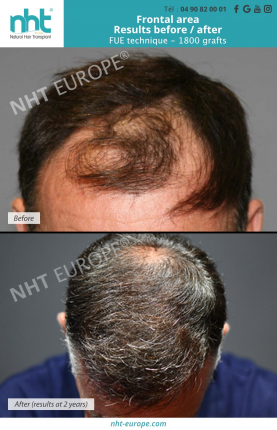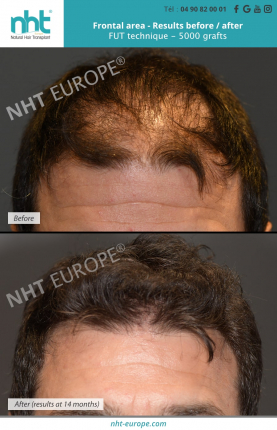Hair Transplants for Men

Hair Transplants for Men
Alopecia, androgenetic alopecia, baldness... Don’t understand why you are losing your hair? Nor what causes it to fall out or its slow regrowth?
In this article, we invite you to understand baldness, learn more about alopecia and its different forms and thus about hair transplantation for men.
What is alopecia? Baldness? Are there several stages of alopecia? What are the different causes of baldness / alopecia? Why have a hair transplant? How does a first consultation session take place? Finally, what treatments do we offer?
We invite you to learn more by browsing these few lines to help you make a free and informed choice about a possible hair transplant for men at our NHT (Natural Hair Transplant) Europe centre, in Avignon.
What is alopecia?
Every day you lose dozens of hairs. And this loss is usually compensated by the growth of new hair. All this is the result of the hair cycle, which is a permanent renewal of the hair throughout life. The duration of this cycle is 3 to 4 years for men and 5 to 6 years for women, which means that the hair disappears every 4 years for men and is renewed.
However, it can occur that the hair stops growing back, or grows back more slowly and that ultimately the amount of hair lost daily is greater than the amount of new hair: this is called alopecia.
Your hair is thus sparse, and this can eventually cause embarrassment, or even complexes.
It is important to know that alopecia can also affect your eyebrows or even your beard.
What is baldness?
Baldness is an advanced form of alopecia; it is the result of hair loss lasting several months or years. Androgenetic alopecia is the most common form of alopecia and is responsible for the vast majority of cases of hair loss in men.
Baldness and / or androgenetic alopecia appears on average between the ages of 20 and 35 but can start later. It results in a gradual receding of the hairline at the top of the forehead, or by hair loss on the top of the head.
In fact, the process can be diffuse, decreasing the density on the top of the head, or start from the posterior area and progress towards the forehead or vice versa.
What is your stage of alopecia?
There are different types of alopecia. As mentioned above, the most common is hereditary androgenetic alopecia which results in a decrease in volume and progressive loss of hair.
It is important to know or have an idea of the stage of your alopecia. To do this, you can refer to the so-called Norwood scale.
The Norwood scale is based on an early scale developed in the 1950s by Doctor James Hamilton.
In the 1970s, Doctor O’Tar Norwood changed the Hamilton scale. This scale quantifies the progression of hair loss in men, grading baldness between 1 and 7.

- In the first stage of male pattern baldness, the frontal-temporal gulfs (temples) become bald.
- During the second stage, type II baldness, hairline recession continues and may be accompanied by thinning of the fringe.
- Then, the phenomenon intensifies: the temples recede further, the hair of the back of the head may begin to disappear causing the creation of an isolated tuft of hair.
- For type IV baldness, there is a widening of the frontotemporal gulfs (temples) as well as a lightening of the fringe area and the vertex.
- Stage V presents the same signs as the previous stage with two anterior and posterior alopecic areas which tend to merge.
- The next stage, the sixth, corresponds to the posterior hollowing out of the vortex (tonsure or top of the skull).
- The evolution of baldness in men ends in Hippocratic alopecia: only the low crowns of hair on the temples and the nape of the neck are visible.
In fact, this classification is of relative interest because there are diffuse forms (DUPA: diffuse unpatterned alopecia) and forms with unusual locations (BUPA: bald unpatterned alopecia); sometimes baldness begins in the vertex and then progresses forward; what is important is whether or not alopecia is progressive, its extent and its origin.
What are the different causes of baldness / alopecia?
The causes of baldness in men are multiple and not always discovered.
For some people, stress can be one of the causes, but it can also be due to smoking, nutritional deficiencies or hormones; endocrine disruptors present in our food undoubtedly also play an important role.
On the other hand, inheritance is a predominant factor.
Androgenetic alopecia affects about 20% of men aged 20 to 22 and 50% of men over the age of 50. It is most often the passing of alopecic genes from the mother or the father, or both that causes this genetic predisposition. Epigenetic factors (diet, lifestyle) modify gene expression.
There is therefore a multifactorial condition with a strong genetic background.
Early detection of a predisposition to this condition is the only way to prevent or stop premature hair loss via personalized treatment.
This is why, since January 2020, we have been using DNA sampling at our NHT Europe centre that allows those affected to explore androgenetic alopecia:
- Determination of the chromosome and the responsible gene
- Nature of the dysfunction
- Evaluation of the effectiveness of treatments before their application
This is a great medical progression that allows us to know in advance the effectiveness of certain treatments over others.
For young subjects, this is fundamental, because alopecia must be stabilized before performing a transplant.
Why have a hair transplant for men?
Depending on the embarrassment caused by the loss of your hair, you may or may not have a complex about it. Baldness can affect your morale.
When the psychological effect of the hair loss is very significant, it must be corrected by a hair transplant.
As previously mentioned, medical treatments can stop the evolution of alopecia in the majority of cases. Today, with new treatments, we can stop the evolution of baldness in 80% of cases. In 25% to 30% of cases, we may even observe hair regrowth, which was uncommon with the previous treatments.
As a reminder, these treatments must be applied over long periods of time; their benefits disappear when they are stopped, which is the main difference compared to transplants.
These treatments are therefore very important for young people, for whom the potential for baldness to progress is usually greater than it is in older people.
In the end, the only sustainable option remains hair transplantation, because the transplanted hair will persist while medical treatments if stopped will be accompanied by a resumption of hair loss.
Today's techniques allow for very natural and permanent results, with a well performed hair transplant by experienced teams. It allows you to have very natural-looking hair again, thanks to an imperceptible hair transplant.
The essential information
In young subjects, treatment must be twofold:
-Medical: to stop the evolution and stabilize the alopecia;
-Surgical: treatment with a hair transplant to compensate for the hair loss that has already happened
Without this medical treatment, hair loss continues to progress, and the psychological improvement of the patient will be incomplete. Hair transplants do not stop hair loss.
How does the first consultation for a male hair transplant take place?

The first medical consultation is a very important step. It is led by a plastic surgeon who first assesses your state of health through a medical questionnaire that takes note of your possible treatments, pathologies, family history...At our NHT Europe centre in Avignon, we make a point of making this session as comprehensive as possible.
During this first session, we are at your disposal, we ask you about your needs, your expectations and your desires. The main objective is to guide you towards developing a coherent and realistic project.
We also use this session to inform you about the different medical or surgical techniques and solutions that we offer within our NHT Europe centre.
Then, we examine in detail the degree of your baldness, the quality of your scalp, its flexibility, your hair density, the texture of your hair, etc. The goal is also to study, and it is essential, the donor area (sampling area) as well as the recipient area (implantation area). The number of hairs per square centimetre, of grafts with 1, 2, 3, or 4 hairs is determined as well as the diameter of the hair.
This is an essential examination to accurately assess the number of grafts that can be taken from the area without altering its appearance.
Then, with this number of grafts available, and the needs of your recipient area, we can elaborate a coherent strategy, and find a medical or surgical treatment, adapted to your situation.
You will see that during this first consultation session, we will work together to find the most suitable treatment plan. We do not influence any of our patients and take into account everything that is crucial to us in a hair transplant. We may be able to recommend against a hair transplant depending on the results of your medical examinations.
What treatments do we offer in our clinic?
We offer several treatments which can be either medical or surgical.
Among our surgical treatments, follicular implantation FUE (Follicular Unit Extraction) of the hair is optimal. Quick, economical and practically painless, this technique is often well known to the general public because it has many advantages, in particular the natural character of these results when it is well executed.
The FUE allows to densify the hair in a natural way and without scarring. A follicular unit (or graft) is made up of 1 to 4 hairs. The grafts are removed using micro-punches 0.6mm to 0.9mm in diameter.
Thanks to this technique, it is possible to perform sessions during which 4000 grafts (from 6000 to 10000 hairs) can be transplanted to obtain an optimal density in one session.
Prior checking of the hair density in the harvesting area is essential to determine the number of grafts available (percentage of follicular units per square centimetre taken making the harvesting invisible).

Minimal shaving on the occipital area to measure the density of your donor area
The absence of scars as well as the preservation of the hair capital in the donor area are the advantages of FUE and is therefore a very preferred technique.
During the hair transplant session: the first step is to take grafts (from the donor areas) in order to reimplant them on the chosen (recipient) areas.
With the FUE technique: harvesting leaves no scars or visible traces on the patient.
Over time, and thanks to technical and scientific developments, FUE hair transplantation has been modernized. Do not hesitate to inquire about our centre which is at the cutting edge of technology. By clicking on the following links, you can find out about our different treatments:
The NHT Europe centre also offers less invasive medical treatments that will allow you to limit your hair loss. For more information, do not hesitate to go to the following sections of our site:
- Genome analysis: DNA sampling
- PRP and nanofat grafting
- Growth factors
- Conventional treatments
- Photobiomodulation
- Food supplements
The results and density observed on the images depend on the number of grafts implanted and the hair thickness.
Each result is therefore different from one patient to another. These images are in no way a guarantee of results.
NHT EUROPE




